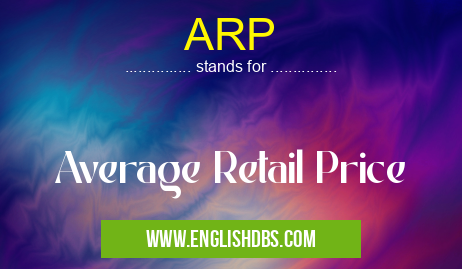What does ARP mean in UNCLASSIFIED
ARP stands for Average Retail Price and is used to measure the cost of goods in different markets, to compare prices against a set average and to gauge the success of marketing campaigns. ARP provides an efficient way to get an overview of how certain products are performing in different markets. It can be used by marketers, retailers, makers and consumers alike.

ARP meaning in Unclassified in Miscellaneous
ARP mostly used in an acronym Unclassified in Category Miscellaneous that means Average Retail Price
Shorthand: ARP,
Full Form: Average Retail Price
For more information of "Average Retail Price", see the section below.
Definition of ARP
ARP stands for Average Retail Price and is a pricing metric used to measure the cost of goods on the market. It is calculated by taking into account all relevant prices observed from different sources, including sales channels, retail outlets, digital platforms and more. The average price is then calculated by dividing total revenue with the number of products sold. The resulting number gives an indication of what people can expect to pay for certain items across markets which helps retailers make pricing decisions accordingly.
Essential Questions and Answers on Average Retail Price in "MISCELLANEOUS»UNFILED"
What is the Average Retail Price (ARP)?
The average retail price (ARP) is the average of all prices that are charged for a specific product. It is the most common used measure to measure the actual price level of consumer goods and services, in order to compare it with other products or services. ARP helps to understand the competitive pricing situation in different markets.
How does one calculate Average Retail Price (ARP)?
To calculate ARP, you need to collect data from various sources such as retail stores, gas stations, supermarkets etc. You can also get data from online surveys and customer reviews in order to have accurate information. Once you have compiled all required data, you should take an average across all listed prices. That will result in a single figure which will be your ARP.
What are some of the factors that affect Average Retail Price (ARP)?
Several factors can affect ARP including local costs of production, overhead expenses, competition from other suppliers, government regulations, industry trends and market conditions. Additionally, geography and seasonality can also play a role in shaping ARP.
Is there any difference between Average Wholesale Price (AWP) and Average Retail Price (ARP)?
Yes, AWP represents wholesale prices while ARP refers to retail prices charged by sellers or retailers for a particular product or service. Moreover AWP is typically higher than ARP due to additional charges like taxes or handling fees added by retailers that consumers must pay when purchasing goods or services from them.
How frequently should companies update their Average Retail Prices (ARPs)?
In general companies should update their ARPs at least once every two months so they remain up-to-date with prevailing market conditions as well as pricing strategies of competitors in order to remain competitive themselves.
How can businesses benefit from knowing their Average Retail Prices (ARPs)?
Knowing your business’s current and updated ARPs enables companies to better understand potential profit margins they can achieve on certain products or services based on current market forces. This helps businesses plan their pricing strategy effectively while keeping current customers happy and attracting new ones at the same time
Why is it important for businesses to track changes in their Average Retail Prices (ARPs)?
Tracking changes in ARPs is important because it allows companies to analyze trends in consumer demand for their offerings as well as helping them evaluate why certain products are selling more than others. This insight enables them adjust accordingly doing things like altering promotional initiatives or even dropping prices if necessary.
Can small businesses benefit from calculating an Average Retail Price?
Yes - Calculating an accurate ARP allows small businesses gain insight into what price point they're currently working with while enabling them make informed decisions about potential discounts or promotions they could employ when trying to increase sales volumes.
Final Words:
Average Retail Price (ARP) is an important metric used by retailers and makers alike in order understand how their products are performing within different markets so they can adjust prices accordingly in order remain competitive or maximize profits where needed. By taking into account all relevant prices observed from different sources including sales channels, retail outlets and digital platforms while also factoring in taxes expenses incurred per country/state – retailers are able to have an accurate indication of what people can expect to pay for certain items across multiple markets.
ARP also stands for: |
|
| All stands for ARP |
